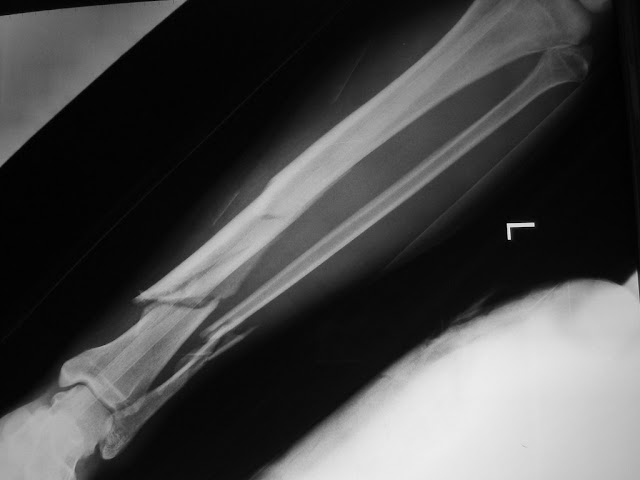Fracture on the tibia is a fracture on the shin bone which is the major lower leg bone that is on the front of the fibula. Since this bone is positioned on the forefront of the lower leg, it is always open to several types of serious injuries. Tibia fractures can be the result of direct trauma to the shin bone, falling from a motorized vehicle, falling from high places or from the weakening of the shin bone due to debilitating diseases such as osteoporosis or bone cancer.
Types
Generally speaking there are three major types of tibia fractures and these are:
Tibial shaft fracture, which occurs at an area between the ankle joint and the knee joint.
Tibial plafond fracture, which occurs near the center of the tibia where the bone joins the ankle. This fracture is quite serious because soft tissues and ankle cartilage are present in these areas.
Tibial plateau fracture, which is the most injurious of all type of tibia fractures because it can affect even the cartilage surface of the bone that is below the knee joint. Most of the times these fracture can develop into knee arthritis.
It may be hairline or spiral tibia fracture.
Tibia Fracture Healing Time:
The tibia fracture recovery time may be above 6 weeks in most cases depending upon the intensity of your fractured tibia.
Diagnosis
There would be a need for clinical examination to find out the status of the tibia. The patient will be asked about the circumstances that led to the injury as well as his previous medical history in relation to the injury. With physical examination, the doctor will assess the tissues around the knee joint and will look for other symptoms such as swelling, bruising, and open wounds. The blood supply from the fractured leg down to the foot will also be assessed. As usual, X-rays will be taken and if required CT scans will also be requested so that the doctor can pinpoint the location and the exact displacement of the fracture.
Causes
Tibia bone fractures can be the result of accidents, falls, or can also be provoked by sports-related injuries. If the person already has a history of a broken tibia, he is also at high risk at injuring his tibia bone again if he will be involved with the same activities he has done before. Cycling, ice hockey, rugby or any quick paced sports that can deliver trauma to the tibia are the major causes of tibia fractures among athletes. In some adults, weak muscles or the overuse of tibial muscles can both increase the risk of having fractures in the tibia.
Symptoms
• There would be pain in the lower extremity when the foot is put with weights.
• There would be deformity mostly around the knee even the fracture happened on the tibia.
• Tenderness and tenseness around the knee area. With such painful sensation there would be limit for the person to bend his knee.
• The foot will look paler and the skin is cooler which indicate that the blood supply is already impaired.
• The foot will be numb or there would be feeling of pain like being pierced with needles and pins on the injured area. This may indicate that there is a nerve injury already.
Tibia Fracture Treatment
Since there are three different types of tibia fractures, there can also be different treatments for each of them. With tibial plafond fracture, casting and internal fixation when there is the displacement and fragments of bone will be required. For tibial shaft fractures, casting is also another way to treat the fractured tibia but sometimes the intrameduallary (IM) rodding is required when there is the need to align the misaligned bone. A metal rod will be placed down the center of the bone through surgical procedure.
With regards to tibial plateu fractures, two kinds of fractures can be done under this category. There is the non-displaced and the displaced tibial plateau fractures. With non-displaced, the treatments may involve only recuperation of the bone and months of therapy while providing protection to the tibia. Surgery may only be needed if there is the need to realign fragmented bones. With displaced tibial plateau fractures, these often require surgery to realign broken bones including the knee joint so that bone stability can be achieved. Screws, plates and screws will bee needed for this method.
Prevention
Be extra careful when playing sports that involve kicking, running, sliding and jumping. With so much intensity these sports can cause instant fracture to the tibia or cause stress fractures which can lead to further damage. If necessary, wear protective footwear to shield the bones in your foot. Always use shoes that have sturdy padding and insoles. When there is swelling or pain in the leg stop doing the activity immediately and rest for days. If the pain persists you have to consult your physician. Eating calcium rich foods can also give you strength in your bone density.
When to Call A Doctor
Find medical assistance at once when you feel that there is severe pain in your injured shin and when you suspect you have a leg fracture from a fall or from any accident. Swelling, numbness of the leg and bleeding will tell you that a rush to the emergency room is needed.

Comments
Post a Comment
Please do not enter any spam link in the comment box.